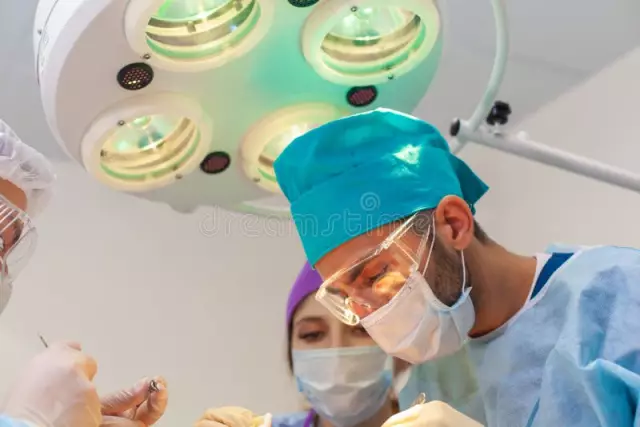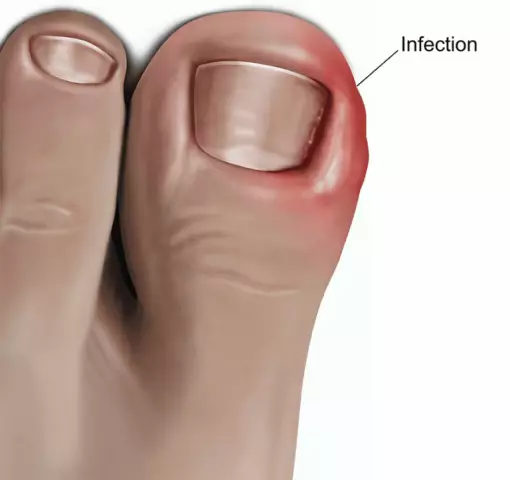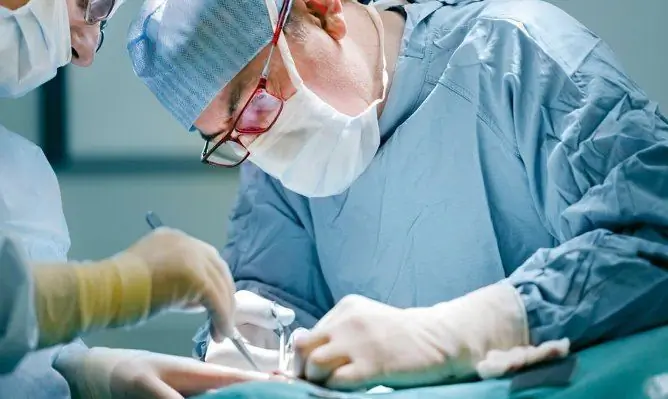- Author Rachel Wainwright [email protected].
- Public 2023-12-15 07:39.
- Last modified 2025-11-02 20:14.
Hirschsprung's disease

Hirschsprung's disease is one of the most common abnormalities in the development of the large intestine, which is manifested by the lack of innervation of a specific section or the entire intestine. Hirschsprung's disease has a genetic etiology. The disease is characterized by the absence of ganglionic cells in the distal intestine. The disease is hereditary and is caused by a mutation in chromosome 10. If diagnosed late, it can provoke the development of acute inflammatory processes in the intestine, as well as lead to death.
Pathogenesis of Hirschsprung's disease
Ganglionic (or ganglionic) cells are the general name for some types of large neurons, which in the intestine are responsible for communication between nerve structures. During ontogenesis, ganglion cells migrate from the upper intestine to its distal section. Impaired migration leads to the formation of an aganglionic section of the intestine (a zone of functional narrowing) with reduced or completely absent innervation (the ability to make progressive-contractile movements). In some cases, the aganglionic site may expand abnormally to form a megacolon, which is one of the serious complications of Hirschsprung's disease.
The site of localization of the aganglionic site, as a rule, is the distal part of the large intestine. In rare cases, there are forms of Hirschsprung's disease, in which the aganglionic segment is formed in the area from the splenic column, or aganglionic disease of the entire large intestine develops. With this form of the disease, patients have total paralysis of peristalsis.
Hirschsprung's disease in children
Due to its etiology, Hirschsprung's disease is diagnosed in newborns or in the first year of their life. However, there are special forms of the disease that fully develop only in an adult organism. The reasons for the development of Hirschsprung's disease in children in ontogenesis are both hereditary factors and impaired intrauterine development. The diagnosis rate for Hirschsprung's disease in children is approximately 1 in 5000. The disease is diagnosed more often in boys than in girls (5: 1). With timely diagnosis and treatment, the prognosis is favorable. In most patients, intestinal motility is fully restored and natural bowel movements are normalized. In 1% of patients, the need for a colostomy (brought out to the anterior abdominal wall and an open end of the colon fixed there) to remove feces and gases.
Hirschsprung's disease: symptoms, diagnostic methods
The main symptoms of Hirschsprung's disease are:
- Constipation;
- Nausea, vomiting;
- Abdominal pain;
- Bloating, flatulence.
The aganglionic segment of the large intestine plays the role of a functional stenosis, above which an abnormal expansion of the intestine is formed, where an accumulation of feces occurs. The severity of the symptoms of Hirschsprung's disease will be directly proportional to the length of the segment of the affected intestine.
In many cases, palpation reveals an accumulation of feces. The main symptom of Hirschsprung's disease in children is a delay in the passage of meconium in the first 24-48 hours. In some children, symptoms may not develop until weaning and switching to solid foods.
In rare cases of Hirschsprung's disease, the symptoms of which are very similar to those of intestinal obstruction, patients develop enterocolitis (inflammation of the colon and small intestine), which provokes diarrhea.

The main methods for diagnosing Hirschsprung's disease are X-ray examination of the intestine using contrast agents, as well as a biopsy of the large intestine. The data obtained by these methods is quite enough for the diagnosis and determination of the localization and stage of development of the disease. In rare cases, ultrasound and anorectal manometry are also used.
Treatment of Hirschsprung's disease: basic methods
The main treatments for Hirschsprung's disease include:
- Diet therapy;
- Conservative treatment;
- Radical treatment.
Diet therapy and conservative treatment of Hirschsprung's disease are temporary measures in preparing the patient for radical (surgical) treatment. Diet therapy is aimed at reducing the manifestation of symptoms in a patient, while conservative treatment is used to eliminate or relieve symptoms.
Radical treatment of Hirschsprung's disease involves surgery, in which the aganglionic section of the intestine is excised with the imposition of an anastomosis. Until recently, operations for Hirschsprung's disease were carried out with the opening of the abdominal cavity and the imposition of a colostomy until normal intestinal motility resumed. Repeated surgery was carried out after a certain time to close the removed colostomy and suture healthy sections of the intestine.
Modern minimally invasive laparoscopic techniques make it possible for Hirschsprung's disease to be operated in one stage, involving excision of the area devoid of innervation and the formation of an anastomosis through the rectal access. Currently, in Hirschsprung's disease, open access operations are performed only in the presence of serious complications, such as enterocolitis or megacolon, which are resistant to conservative methods of treatment.
YouTube video related to the article:
The information is generalized and provided for informational purposes only. At the first sign of illness, see your doctor. Self-medication is hazardous to health!






